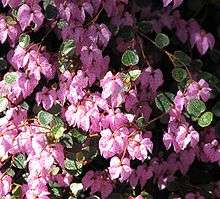Thomasia pygmaea
Thomasia pygmaea, commonly known as the tiny thomasia,[2] is a small shrub which is endemic to the south-west of Western Australia.
| Tiny thomasia | |
|---|---|
 | |
| Scientific classification | |
| Kingdom: | Plantae |
| Clade: | Tracheophytes |
| Clade: | Angiosperms |
| Clade: | Eudicots |
| Clade: | Rosids |
| Order: | Malvales |
| Family: | Malvaceae |
| Genus: | Thomasia |
| Species: | T. pygmaea |
| Binomial name | |
| Thomasia pygmaea | |
| Synonyms | |
|
Asterochiton pygmaeus Turcz. | |
Description
It grows to between 0.05 and 0.3 metres in height.[3] Flowers are produced between August and November in its native range.[3] These are pinkish-mauve and covered with small red dots.[4]
Taxonomy and naming
The species was first formally described by botanist Nicolai Stepanovitch Turczaninow in Bulletin de la Societe Imperiale des Naturalistes de Moscou in 1806.[5] He gave it the name Asterochiton pygmaeus .[5] George Bentham transferred the species to the genus Thomasia in 1863.[5]
Cultivation
Thomasia pygmaea is an attractive small shrub, useful for edging, container growing or in rockeries.[4] It requires a light soil with good drainage and tolerates some shade and light frost.[4]
References
- "Thomasia pygmaea". Australian Plant Census. Retrieved 8 October 2019.
- "Thomasia pygmaea". Australian Native Plant Society. Retrieved 8 October 2019.
- "Thomasia pygmaea". FloraBase. Western Australian Government Department of Parks and Wildlife.
- Greig, D. (1987). The Australian Gardener's Wildflower Catalogue. Australia: Angus & Robertson. ISBN 0207154600.
- "Thomasia pygmaea". Australian Plant Name Index (APNI), IBIS database. Centre for Plant Biodiversity Research, Australian Government.